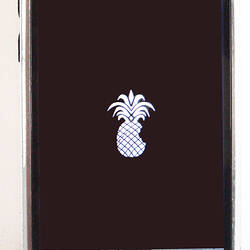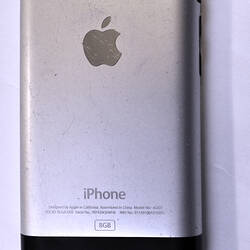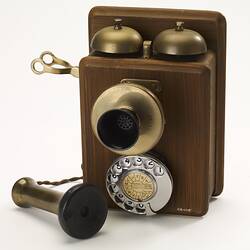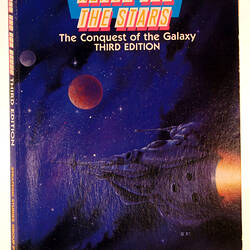Summary
Apple first generation iPhone, a personal digital assistant, which includes a mobile telephone, a hard drive based MP3 player, and an 8GB hard disk, it comes with a USB cable.
The iPhone functioned as a personal digital assistant and telephone through applications (known as apps), which appear as icons on a touch-sensitive screen. Some apps are pre-installed, whereas other apps can be downloaded from the Apple iTunes Store either for free or after payment of the cost of the app. One app is the iPod app, which allows the iPhone to function as an iPod and play music, videos and podcasts as well as display electronic books (eBook).
This particular item was purchased in October 2007 by a Victorian whilst on a business trip to USA. He brought it back to Melbourne and adapted it for Australian conditions. To do this, he unlocked it so that its SIM card could 'talk' with the telephone service of an Australian telecommunications company (Telstra), instead of the American telecommunications company AT&T.
The iPhone's success was due to its novel industrial design and in following the Apple tradition of ease of use, for example in downloading apps and music from the Apple iTunes store. It is not just a phone, but a multi-purpose device.
Part of a representative collection of hardware, software, trade literature and promotional material that documents the history of the Apple Company and its contribution to, and impact on the computer industry and society.
Physical Description
Apple iPhone with USB cable. The tablet has a plastic black rectangular body with aluminium back and a touch-sensitive screen built into part of the top surface. On the front is a circular button home/wake switch. On the top edge is an on/off switch and ear phone socket. On the bottom edge is a socket for the USB cable.
Significance
The Apple iPhone was the first combined mobile phone-personal digital assistant to dominate the commercial market. In the space of less than a year it became the product which other major mobile telephone corporations sought to emulate. The innovative use of a touch screen to trigger icon-based actions, including the incorporation of an icon-based keyboard, made the iPhone easy to use, in keeping with Apple's industrial design tradition, and immediately establishing the product as a leader in its field.
More Information
-
Collection Names
The Apple Company Collection, Internet Macintosh User Group (iMug) Collection
-
Collecting Areas
-
Acquisition Information
Donation from internet Macintosh User Group (iMug), 13 Aug 2010
-
Manufacturer
Apple Computer Inc, Cupertino, California, United States of America, 2007
-
Place & Date Purchased
-
Place & Date Used
-
Inscriptions
On back: [Apple logo] iPhone/Designed by Apple in California Assembled in China Model No: A1203 / FCC ID:BCGA1203 Serial No: 7R7420Q6WHB IMEI No:011301005316095 / 8GB
-
Model Name or Number
-
Brand Names
-
Classification
-
Category
-
Discipline
-
Type of item
-
Overall Dimensions
61 mm (Width), 12 mm (Depth), 115 mm (Height)
USB cable is 1135mm long.
-
Keywords





